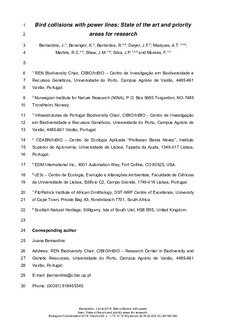Bird collisions with power lines: State of the art and priority areas for research
Bernardino, J.; Bevanger, Kjetil Modolv; Barrientos, R.; Dwyer, J.F.; Marques, A.T.; Martins, R.C.; Shaw, J.M.; Silva, J.P.; Moreira, F.
Journal article, Peer reviewed
Accepted version

Åpne
Permanent lenke
http://hdl.handle.net/11250/2493920Utgivelsesdato
2018Metadata
Vis full innførselSamlinger
- Publikasjoner fra CRIStin - NINA [2364]
- Scientific publications [1392]
Sammendrag
Transmission and distribution electricity grids are expanding rapidly worldwide, with significant negative impacts on biodiversity and, in particular, on birds. We performed a systematic review of the literature available on bird collisions with power lines to: (i) assess overall trends in scientific research in recent decades; (ii) review the existing knowledge of species-specific factors (e.g. vision, morphology), site-specific factors (e.g. topography, light and weather conditions, and anthropogenic disturbance), and power line-specific factors (e.g. number of wire levels, wire height and diameter) known to contribute to increased bird collision risk; and (iii) evaluate existing mitigation measures (e.g. power line routing, underground cabling, power line configuration, wire marking), as well as their effectiveness in reducing collision risk. Our literature review showed (i) there is comparatively little scientific evidence available for power line-specific factors, (ii) there is a scarcity of studies in Asia, Africa and South America, and (iii) several recommendations of good practice are still not supported by scientific evidence. Based on knowledge gaps identified through this review, we outline suggestions for future research and possible innovative approaches in three main areas: bird behaviour (e.g. further use of loggers and sensors), impact assessment (e.g. understanding the drivers of mortality hotspots, assess population-level impacts, develop methods for automatic detection of collisions) and mitigation measures (e.g. further need of BACI approaches to compare the effectiveness of different wire marking devices). The complex and region-specific interactions between collision drivers and bird ecology continue to limit our ability to predict impacts and the success of mitigation measures. Bird mortality Collision risk Impact assessment and mitigation Energy Knowledge gaps Transmission and distribution lines
